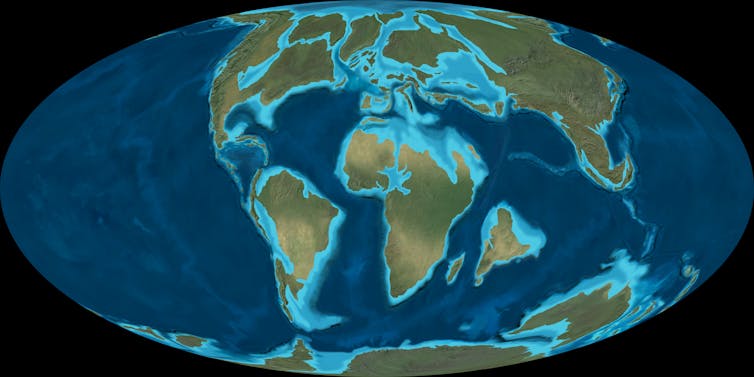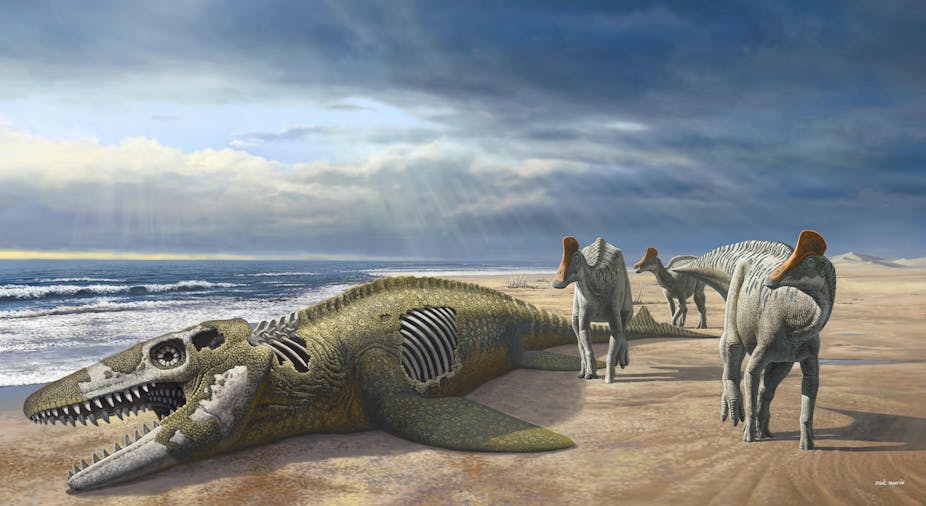Why are fossils of duckbill dinosaurs, a North American family, found in North Africa?
Dinosaurs couldn’t just walk there. Sixty-six million years ago, when duckbills suddenly appear in Africa’s fossil record, the world’s land masses formed a series of islands. A seaway divided eastern and western North America; Europe was an archipelago. South America, India, Australia and Madagascar were all island continents, surrounded by ocean.
Africa was an island too – it was impossible to walk there from North America. And yet, somehow, we’ve now found fossils of duckbill dinosaurs in Morocco.

Continental breakup
Go far enough back in time, 200 million years ago, and the continents are all united into one land mass, the vast supercontinent of Pangaea. At this point, you could’ve walked between North America and Africa. But this doesn’t explain the mystery of Africa’s duckbills. Pangaea broke up tens of millions of years before duckbills evolved, and by 100 million years ago, Africa had split off from South America and became isolated.
The first duckbill dinosaurs evolved in North America around 90 million years ago – after all the land connections were broken, when Africa was isolated by hundreds of kilometres of open sea.
But five years ago, our team of palaeontologists found the jawbones of a tiny dinosaur in Morocco. These fossils come from a little, pony-sized animal we named Ajnabia odysseus, the first African duckbill. Somehow, little Ajnabia‘s ancestors got to north Africa.
Now, we’ve found new fossils in Morocco which deepen the mystery. They not only confirm that duckbills colonised Africa, they show duckbills rapidly diversified once they got there.
Read more: Morocco dinosaur discovery gives clues on why they went extinct
More little duckbills
One of these fossils is the partial skull of a new species, Minqaria bata (Arabic for “beak” and “duck”). Minqaria’s teeth are broader and blunter than Ajnabia’s, and the jaws have a sinuous shape, suggesting it filled a distinct ecological niche. Minqaria also preserves a braincase. The skull bones are tightly knit as in adults, so despite its small size, Minqaria was fully grown.

North American and Asian duckbills were giants: they grew up to 15 metres long and could weigh 10 to 20 tonnes. Minqaria was just a few metres long and weighed maybe 250kg; Ajnabia was similar in size. Two bones found a few kilometres away – a humerus and a femur – come from bigger duckbills, 5-6 metres long, hinting at a third, larger species.

It seems that once duckbills arrived in Africa, they quickly diversified, exploiting open niches. They may have specialised in the small herbivore niches, where they faced less competition from the giant, long-necked titanosaurian sauropods.

Curiously, Minqaria’s skull resembles that of French and Spanish duckbills, confirming our hunch that the Moroccan duckbills are related to the European species. It appears duckbills emigrated from Europe, but how?
Hundreds of kilometres of ocean separated Africa and Europe in the Cretaceous. Emergent islands may have helped to bridge the gap, but there’s little evidence for a land bridge. Duckbills couldn’t walk to Africa. That leaves us with an ocean crossing.
This seems unlikely, but as Sherlock Holmes said:
when you have eliminated the impossible, then whatever remains, no matter how improbable, must be the truth.
There are several ways animals might cross an ocean. Some animals can float long distances. Tortoises float surprisingly well, and can survive months without food or water.

In 2004, a tortoise washed ashore in Tanzania after drifting from the Seychelles, 700km away. The animal had been at sea so long, it was covered in barnacles – yet, astonishingly, it was alive. That’s probably how tortoises colonised the Galapagos.
Sometimes animals hitch a ride on floating vegetation. In 1995, after a hurricane hit the Caribbean, a group of iguanas washed up on Anguilla, clinging to debris. They probably came from Guadeloupe, 300km away.
Many species swim well. Deer swim frequently, and have been seen swimming up to 25km between islands in the Great Lakes in North America. Elephants can swim almost 50km to reach offshore islands. That’s probably how deer and elephants got to Crete and Sardinia during the Pleistocene.
One way or another – floating, rafting, swimming – duckbills crossed water to Africa. Possibly a herd was washed out to sea, then drifted and swam with the currents. And while full-grown duckbills would have been too big to raft, tiny hatchlings could have ridden on floating vegetation. However it happened, duckbills crossed the sea. And since Europe was also isolated from Asia by a seaway in the Cretaceous, they may have first had to cross water to get to Europe.

This sort of thing may be far more common than we think. A number of other perplexing dinosaur occurrences hint at oceanic dispersals. The spread of titanosaurs from South America to North America, and the spread of another tribe of duckbills, the kritosaurs, into South America probably involved ocean crossings.
The big picture
Why does it matter if dinosaurs crossed oceans?
It matters because it shows how rare, extreme, improbable events can have a big impact on evolution. Charles Darwin thought everyday processes drove evolution – processes like competition, predation, mate choice. And given time, everyday events will add up to create huge changes. But it’s also the case that if you wait long enough, very weird, unlikely things happen. Given time, highly improbable events can become highly probable, even inevitable. Over vast spans of time, freak events – asteroid impacts, “Snowball Earth” glaciations, massive volcanic eruptions and oceanic crossings – shape evolution. Not just dinosaur evolution, either.
Human evolution could be one of those astonishingly rare occurrences, or maybe the result of a series of highly improbable events. Curiously, when our primate ancestors came from Asia to Africa 50 million years ago, it was still an island. The arrival of primates in Africa, which began the evolution of monkeys, apes and finally Homo sapiens, was also due to an incredibly lucky ocean crossing. A small group of primates was swept out the sea. Against all odds, they survived, perhaps clinging to rafts of floating trees. Then, improbably, they washed up in Africa, survived, multiplied – and evolved into us. What the fossils tell us is that evolution isn’t just about survival of the fittest. As much as anything, it’s about the survival of the luckiest.

